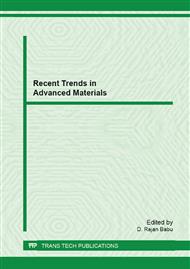p.285
p.290
p.295
p.299
p.303
p.308
p.313
p.319
p.324
Effect of Microwave Sintering on the Structural and Electrochemical Behavior of Yttria Substituted BaCeO3 Nanocomposites for Solid Oxide Fuel Cell (SOFC) Applications
Abstract:
Abstract. The Yttria substituted BaCeO3 nanocomposites were prepared by modified Pechini technique followed by novel microwave sintering at 1400°C. The powder XRD results show that the material exhibit orthorhombic crystalline structure. The average grain size was calculated to be as 55 nm. SEM results show that the homogeneous distribution of particles in the lower nanometer range leads to dense microstructure. DTA peaks at 575 and 648°C indicate that the crystallization of the material and the associated weight losses were observed in the TG curve. The 96% of theoretical density was measured for the sintered sample through Archimedes principle. The maximum power density of 788mWcm2 and the maximum open voltage (OCV) of about 0.991 V was measured from the I-V and I-P results. The results confirm that the microwave sintering technique enhances the material properties in the nanometer scale with large potential for SOFC applications.
Info:
Periodical:
Pages:
303-307
Citation:
Online since:
October 2012
Price:
Сopyright:
© 2012 Trans Tech Publications Ltd. All Rights Reserved
Share:
Citation:


